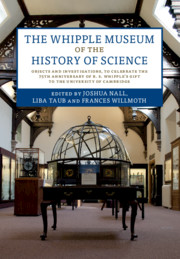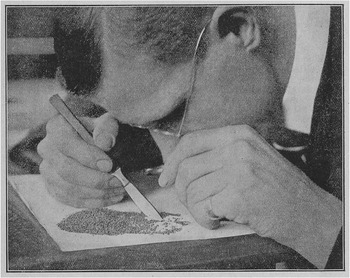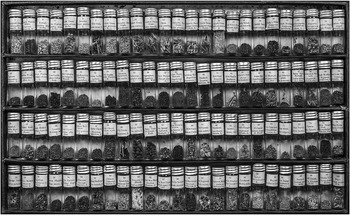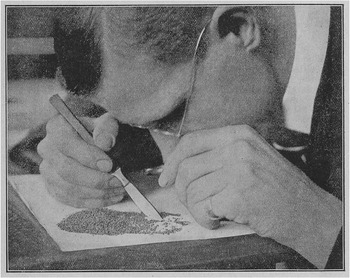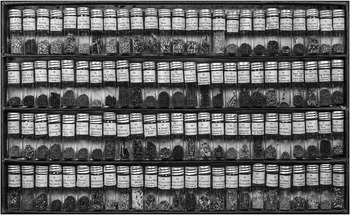‘A plant where you don’t want it’. ‘A noxious or useless plant’. ‘A plant out of place’. ‘A troublesome plant’. ‘A plant not edible, so far as known, nor medicinal, or otherwise serviceable to man, and which always thrives where not wanted’. ‘A plant for which we have no use so far as we know’. ‘Any plant from which its situation or inherent properties is harmful to human interests; a vegetable malefactor.’Footnote 1 These definitions of ‘weed’, gathered via an American botanist’s informal survey in 1892, might just as easily have been collected today. We all know that weeds are unwanted pests. Or do we? In the late nineteenth century, some agronomists and botanists came to see the very same plants as desirable, useful, and well-placed for solving a particularly tricky question. Their thinking transformed vegetable malefactors into benefactors.
This re-imagining of the useless weed is evident in a small seed herbarium owned by the Whipple Museum, which contains seeds of plants originating across Europe, the Middle East, and the Americas: Crepis biennis, or rough hawksbeard, a lanky biennial herb with bright yellow flowers that was originally native to Europe; Rudbeckia hirta, the black-eyed susan, a showy little sunflower hailing from North America; and Delphinium consolida, also known as forking larkspur or royal knight’s-spur, a purple-flowering annual common to Eastern Europe.Footnote 2 The Whipple’s herbarium (Figure 10.1) comprises small samples of seed from these and ninety-seven other species, labelled and arranged in a commercially manufactured microscope slide box. Little was known about this seed collection when the Whipple Museum acquired it. There was no place or date of creation, no record of its ownership, and, most pressingly, no knowledge of the uses for which it had been intended. The handwritten outer label, ‘Origin of Seeds Source Indicators’, and contents list within, which provides information about each sample’s status as something called a ‘source indicator’ via the listing of miscellaneous forage crops, provided no immediate answers.
In pursuing the history of this object for the Whipple Museum, I discovered it was itself an unusual specimen. Like other seed herbaria, such as those kept by individual botanical researchers or by institutions such as botanical gardens and arboreta as reference tools for identification and classification, this small collection enabled its handler to identify the species or genus of a seed via its visible characteristics.Footnote 3 The ultimate aim of this initial identification, however, was not to learn more about the seed being compared with the herbarium specimens, as one might typically expect. Instead, it was to correctly categorise still other seeds, ones with potentially far more value. The Whipple’s herbarium was not an all-purpose reference tool but one designed to facilitate a specific agricultural task. To the extent it was ever used, it enabled its user to deploy the unwanted weed seeds inherent in commercial seed stocks as much-needed evidence of the geographical origins of those stocks – that is, as ‘source indicators’. To that end, it contains only the seeds of weeds commonly found among forage or fodder crops and of circumscribed geographical distribution.Footnote 4
This simple explanation of the contents and intended uses of the Whipple’s enigmatic herbarium belies the challenges that are likely to have confronted its users. As I describe here, the need to assess the geographical origin of commercial seeds had arisen as a consequence of an increasingly international seed market. Although seed-testing stations adopted the use of weed seeds as indicators of provenance, this mobilisation of agricultural pests (weeds) in the service of agricultural improvement (accurately labelled seed) proved troublesome. By highlighting the folly of premising a static laboratory instrument, intended to manage the tumult of international agricultural exchange, on the assumption of a stable global plant biogeography, my effort to shed some light on the Whipple Museum’s seed herbarium ends with a lesson that is as much environmental history as object history.
Noxious Plants
It is rarely straightforward to label a plant as a weed. Botanists have been at pains to point this out for decades, and environmental historians have recently joined them. Consider that the opportunistic Tree of Heaven is vilified as a noxious invasive in Australia, the United States, and parts of Europe but celebrated as a medicinal plant in its native China. Or that one person’s troublesome lawn pest is another’s dandelion salad. Or that an oat seedling is a weed when found in a field of wheat. What counts as a weed depends not so much on the plant as on the person looking at it and the place they happen to be standing.Footnote 5 Nonetheless, even if the label is constrained by time, place, and culture, a plant ‘growing where it is not desired’ is typically thought of as a weed.Footnote 6 Perhaps it is more accurate to say that such a plant is typically reviled as a weed. Weeds have a truly bad rap, so much so that the menace of weedy plants to agriculture is often sufficient to mobilise military language, and military tools, in response.Footnote 7 Equally tellingly, the metaphors of weeds and weeding have appeared wherever certain kinds of people have been designated undesirable, whether criminals, immigrants, or perceived eugenic threats.Footnote 8
Many of the plants commonly designated as weeds share a suite of characteristics that help them thrive in recently disturbed habitats – places like agricultural fields, home gardens, construction sites, and roadsides – and to disperse themselves quickly and widely.Footnote 9 Humans are incredibly talented at creating spaces in which these peregrinating plants thrive.Footnote 10 As a result, they follow us everywhere. In the words of the botanist Edgar Anderson, ‘The history of weeds is the history of man.’Footnote 11 A handful of environmental historians have made hay from this insight, casting weeds as decisive actors in human history. Among other achievements, weeds are said to have enabled European colonisation in temperate climates, attuned displaced settlers to new environments, and united prickly farmers to common purpose in the American West.Footnote 12 It is the mobility of weeds, their movement with us and despite us, that has made them so unexpectedly influential. This was true even in the laboratory, where the movement of weeds underlies the creation, and very probably the abandonment, too, of the Whipple’s weed seed herbarium.
To understand the intended functions of this herbarium, it is essential to first understand some dysfunctions of the international seed market of the late nineteenth century. Expanding markets for grain and other agricultural products had created new demand for commercial seed, and many eager producers, vendors, and middlemen clamoured to meet it.Footnote 13 If contemporary accounts are to be believed, their number included all sorts of unscrupulous individuals. Reports of deceptive sales boomeranged across Europe and North America, tales of miscellaneous seeds sold as pure strains, old stock coloured to look fresh, seeds of worthless plants used to bulk up prized varieties, and uncleaned seed sold rife with weeds.Footnote 14 One widely circulating story held that a German firm was discovered offering seed dealers quartz stone ‘so agreeing in size and colour with red or white clover [seed] that the farmer could not distinguish them’.Footnote 15
These abuses were particularly rampant in the sale of seed for forage crops such as clover, alfalfa, timothy, and rye grass. ‘Red clover is usually the foulest seed sold on the market,’ advised an 1894 US agricultural bulletin.Footnote 16 In comparison with grain crops, forage tended to be poorly weeded, if at all, which meant that weed seeds ripened alongside crop seeds and were most often caught up in the harvest.Footnote 17 And whereas farmers tended to select with care the seed they used for corn, wheat, and other grains, choosing either from their own harvest or from some nearby producer, far less deliberation went into obtaining seeds for forage. This led to more instances of adulteration and badly cleaned seed than seen in other seed crops. ‘It may almost be said that the average farmer buys the cheapest seed in the market and trusts entirely to luck for it to produce the desired crop,’ lamented one botanist of forage seed sales. He rued in particular the crop of weeds that tended to spring up from such thoughtless plantings, as their subsequent eradication inevitably cost the farmer far more than the premium on a bag of good, clean seed would have cost.Footnote 18
Seed Testing
The notoriety of bad seed, and the real and imagined havoc that it wreaked for individual farmers as well as for regional and national productivity, led private firms and national governments to varied methods for ensuring the circulation of ‘pure’ seed. These ran the gamut, from instructional materials that taught farmers how to assess the quality of their seed purchases to laboratories where seed analysts (typically women) evaluated seed, to regulations allowing, or even compelling, state evaluation of commercial seed. Central to all of these was the seed test, a set of methods and tools for judging the quality of a seed stock: its genuineness, purity, and capacity for germination. Many accounts credit the botanist Friedrich Nobbe of Saxony with formalising seed testing. In 1869 he opened what is considered to have been the first seed-testing station at Tharandt, simultaneously setting out some basic principles for running such a station. His ideas proved immensely popular among farmers and governments, and seed dealers, too, who benefited from being able to sell guaranteed pure seed. By the end of the century, there were reportedly 119 seed-testing stations operating along similar lines in nineteen different countries.Footnote 19
Although procedures varied from site to site, especially with regard to the extent of involvement of the state and the nature of an institution’s relationship with commercial seed dealers, the actual process of testing followed a set pattern. After preparing a representative sample of a given stock, a seed analyst determined the genuineness of the sample – that it was indeed seed of the indicated crop species, originating from the indicated country or region – and its purity. The latter involved her examining a subset of seeds from the sample, say 1,000, and separating whole healthy seeds of the desired crop from dirt, straw, and seeds of other species to arrive at a percentage of pure seed. She would then find the average weight of the seed lot, possibly assess its moisture content, and make a final assessment of quality by testing its germination rate. The results of these assessments were then compiled, often on standardised forms, and provided to whomever had requested the test.Footnote 20
Some aspects of seed testing were demanding of an analyst’s patience and knowledge, not least the sorting of hundreds of minute seeds and their subsequent identification (Figure 10.2). Everyone agreed that a seed herbarium – that is, a collection of identified seed specimens – was an essential aid to the latter, even for the most knowledgeable botanists. These reference collections were often assembled over time, through aggregation and exchange among individual researchers or collectively at botanical institutions. And there was a fair amount of equipment beyond a herbarium involved in seed testing. As an 1895 textbook specified, the ‘very simple’ necessary equipment included ‘a small magnifying glass, some sieves of various grades, bellows, forceps, delicate scales, thermometers, jars, test-plates, chemical tests, and a good knowledge of botany’.Footnote 21 At the large seed-testing stations, equipment grew significantly more complex, especially over time, and microscopes, mechanical separators, incubators, germinators, and other devices increasingly crowded laboratories’ spaces.Footnote 22 Still, the processes of testing were straightforward enough – save one. Even with all the best equipment, determining the place of origin of a seed stock could be a real pain.
The chief obstacle to identifying a seed’s origin was that seeds of the same species from different countries or regions or even continents did not necessarily look any different from one another. Yet they were decidedly not the same. When cultivated in a particular area over a long period of time, crops become locally adapted, responding to the climate and soils of the place where they are grown. As a result, seed harvested from one location might not perform as well in another, and in some cases might not grow at all. For example, seeds from a southern latitude might fare poorly at a northern one, as a result of shorter seasons or colder winters. A Canadian agronomist summarised in 1925 what was by then a commonplace: ‘The superiority of home grown seeds over imported seeds has been demonstrated in nearly all countries and for so many kinds of crops that enumeration of the experiments would lead too far.’Footnote 23
Unfortunately, the vagaries of harvests from year to year and the inevitable roller-coaster of agricultural prices led to uneven seed supply and demand, which in turn meant that seeds often came from far afield. This was especially true in the case of forage and fodder crops, as farmers were less likely to produce seed for these on-farm.Footnote 24 The general lack of attentiveness to the quality of forage crop seeds compounded the problems created by a shortage of locally produced seed. The result? An anything-goes international market in which the origin of forage crop seeds was often misrepresented. The Swiss agronomist Friedrich Stebler characterised the problem in his country with respect to red clover in the 1880s: ‘American seed, for example, is often sold as English or German seed … American is inferior to European seed; as it is cheaper, it is often advantageous for the seedsman to substitute the former for the latter.’Footnote 25 Across the Atlantic, the perspective was the reverse. Canadians needed seed testing as protection against ‘imported southern grown seeds’ coming from Europe and the United States, meanwhile US farmers were advised to use American-grown seed rather than European.Footnote 26
The problem of origins resulted in a kind of seed nationalism, one exacerbated by knowledge of further harms arising from imports. A lacklustre harvest might be only the start. Because poor-quality forage seeds were often badly cleaned or even deliberately bulked with the detritus left after cleaning other crops, they were a chief source of weeds. Americans knew well that the most aggressive weeds tended to have arrived from abroad. ‘Nearly all of our worst weeds are of European origin, and by far the greater part of them have been introduced into American soil through impure seed’, claimed a typical rant of a US agronomist.Footnote 27 This particular researcher thought the problem had been made worse by seed regulations – specifically, by the imbalance in these between the United States and Europe. ‘While seed-control agitation in Europe has resulted in a marked improvement of home stocks, it does not prevent the shipment of poorly cleaned seed to other countries,’ he explained. ‘[A]s a result a large proportion of our inferior seed comes from abroad.’Footnote 28 Though perhaps more exercised on the issue, Americans were not alone in their concerns about the introduction of new weeds through imported seeds. The transfer of dodder seeds from one part of the globe to another was a near-universal concern, in part because everyone already knew the local kind of these parasitic plants to be a real pain.Footnote 29
Foreign seeds, in short, portended various farm disasters. But how could a seed analyst discover potential immigrant stocks circulating amidst those native-born, when the seeds themselves looked nearly identical?
Here is where the worthless, and sometimes worse-than-worthless, weeds proved their merit. Although crop species had globalised, and some weeds, too, many common weed species remained geographically circumscribed. Where this was the case, the presence of their seeds amidst a stock of crop seeds could be used to identify the region of the world, or in some cases the part of a country, in which that stock had been produced. Friedrich Stebler in Switzerland expanded this general insight into a system for origin identification in the 1880s and 1890s using his meticulous observations of the weed seeds that accompanied stocks to his seed testing station in Zurich. ‘Source indicators’ were weed seeds that he felt faithfully linked a tested seed to some world region, such as Southern Europe or North America. What he called ‘companion seeds’ gave some insight into origins, though their presence was not sufficient to confirm it.Footnote 30
Useful Weeds?
Stebler’s method (though not necessarily his terminology), soon became standard practice for identifying place of origin in laboratory evaluations of seed.Footnote 31 The Whipple Museum’s herbarium was created to facilitate such identification, either by its use in direct comparisons or in training seed analysts to recognise different species. It contains only those weed seeds considered to be so-called source indicators or companion seeds, and not the whole gamut of weed species that would be expected to emerge from sacks and samples amidst routine testing. More typical seed herbaria kept for use at agricultural research institutions, including seed-testing stations, would contain examples of agricultural crops as well as weeds, the latter regardless of whether they could be used as source indicators (Figure 10.3).Footnote 32 By virtue of including a wide range of plant material, local and global, these herbaria were (and are) suited to dealing with varied needs of researchers and farmers. In contrast, the Whipple’s seed herbarium was tailored to a single task: the identification of a seed’s place of origin.
The deployment of weeds as instruments of seed testing turned some of the most common definitions of these notoriously pesky plants on their head. The noxious, useless plants out of place were now wanted, beneficial, and perfectly positioned – at least some of the time. The contradictions inherent in appreciating weeds as contributors to agricultural efficiency surfaced almost immediately. Seed testing prized purity. The best stocks were free of seeds from other species, whether crop or weed, and of other debris that might add to their weight and therefore their price without adding to the value of the future crop. But a well-cleaned bag of seed, earning high marks for purity, contained few weeds, and therefore its origins were more difficult to certify. By the 1920s, very clean seed could be construed as an obstacle for seed analysts, as much as a goal, as it necessitated the development of new methods for determining origins. ‘The combined result of modern improvements in cleaning machinery and the introduction of the Testing of Seeds Order [mandating assessment of commercial seeds prior to sale] is … for cleaner and cleaner samples to be put on the market as time goes on. It was, therefore, decided to start investigations with a view to establishing, if possible, a “country of origin test” other than “impurity”,’ explained a British botanist who was leading investigations into what he called a ‘Nationality Test’ for red clover.Footnote 33 Where weeds were wanted, purity was a problem.
Even if improvements in seed cleaning had not been a concern, the method of determining the origin of crop seeds by virtue of the weeds that travelled with them was far from foolproof. The problem was movement. An important feature of the species frequently identified as weeds is that they turn up in new places unbidden, often much to the chagrin of cultivators. Some of the travelling of weeds that caused a problem for seed analysts was small-scale and human-engineered. Already classed as an impurity in the seed-testing world, seeds of reliable source indicator species were soon also being understood as potential adulterants. Savvy but unsavoury seed merchants or wholesalers could deliberately add ‘certain weed seeds suggestive of an origin heavily in demand’ with the purpose of misleading buyers or testers.Footnote 34
The more critical undermining of Stebler’s source indicator method did not result from these premeditated movements, however, but rather from those more inherent to weed species. As I have already described, these plants out of place are notorious globetrotters, hardy travellers whose cross-country and cross-continent journeys are typically and often unknowingly facilitated by human companions.Footnote 35 It was utterly reasonable to assume, therefore, that weeds that were still comparatively provincial would prove themselves more cosmopolitan in time. Their transport was already arranged: easy transit from a Russian farm to a Canadian or Swiss or British one via the boats and trains and carts and sacks of the international seed market. ‘The opinion has often been expressed that the leading species will in time become worthless as clues [to origin] because of the international trade in seeds,’ reported a Swiss agronomist in 1925. Curiously, he expressed his scepticism of this ‘opinion’ but then enumerated several cases in which weeds had been rendered useless precisely because they had become ‘too cosmopolitan’.Footnote 36 The propensity of weeds to behave as weeds so famously do meant that using these to gauge a seed stock’s place of origin had to be done more carefully with each passing year. A British seed manual of 1938 advised that, ‘[I]n view of the international traffic in seeds, which has been ongoing for generations, weeds have been transported to new areas all over the globe’. As a result, they were only rarely ‘diagnostic’ of origin. The seed analyst could, however, still ‘form a shrewd opinion of origin from the profusion of some characteristic species’.Footnote 37 Considering the quantity of weed seeds and their particular combinations was advised, rather than simply looking for the presence of any one species. Weed peregrinations also necessitated that the lists relied upon as indicators be thought of as ever-changing, rather than set in stone.Footnote 38
In short, transforming weeds into reliable laboratory instruments proved difficult. Seed testing created a purpose for useless plants, a desire for the undesirable. In spite of this re-categorisation, however, weeds continued to be weeds. The wild and woolly seed trade they were meant to tame instead encouraged their own unruly behaviour. Just like the crops they travelled with, they set down roots in new places – but, unlike those crops, they had not been invited to do so. Although we still know few specifics about the Whipple Museum’s ‘Origin of Seeds Source Indicators’ herbarium, it seems safe to speculate that it had a limited lifespan. It ultimately served more as a snapshot of global agricultural history at the time of its creation than as an enduring tool for assessing the products of global agriculture.

